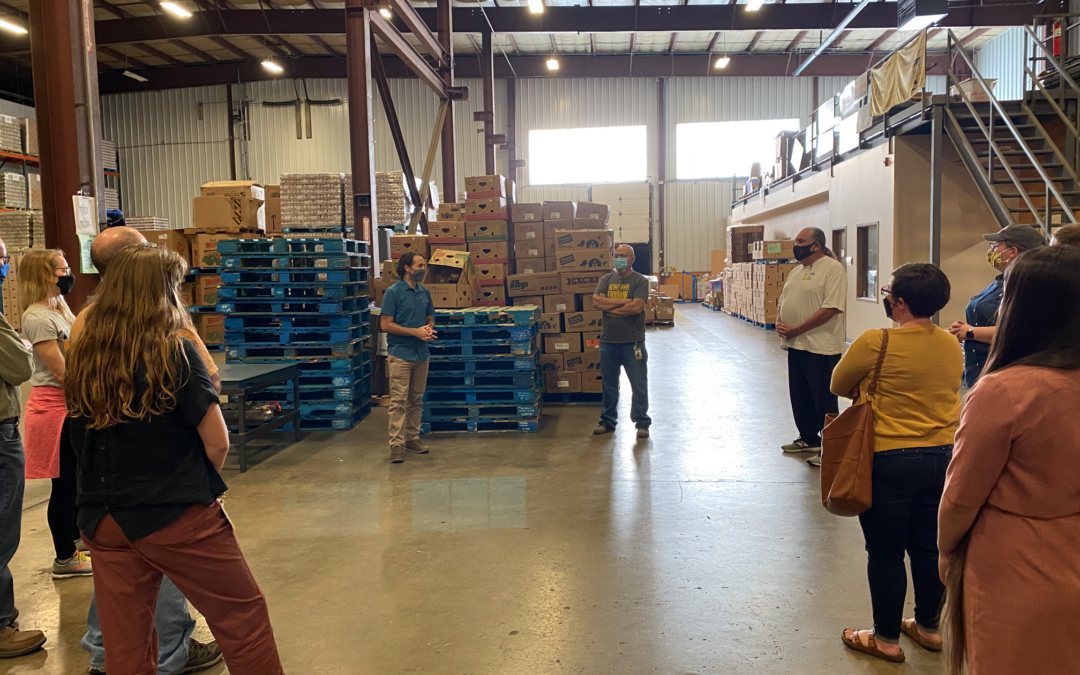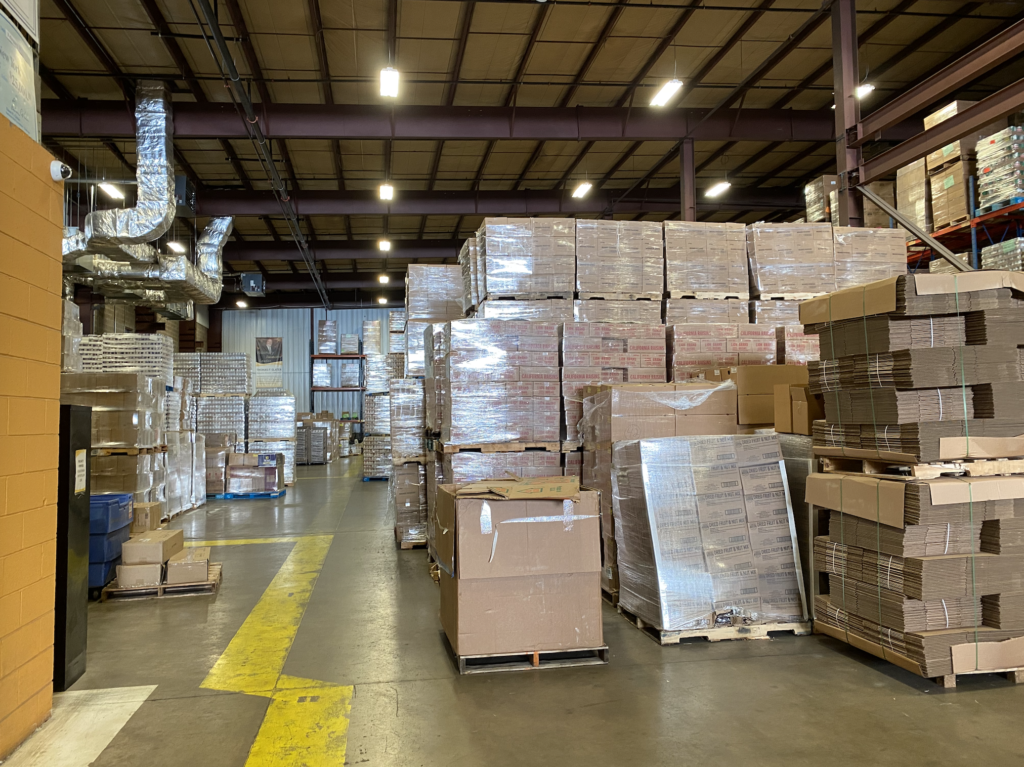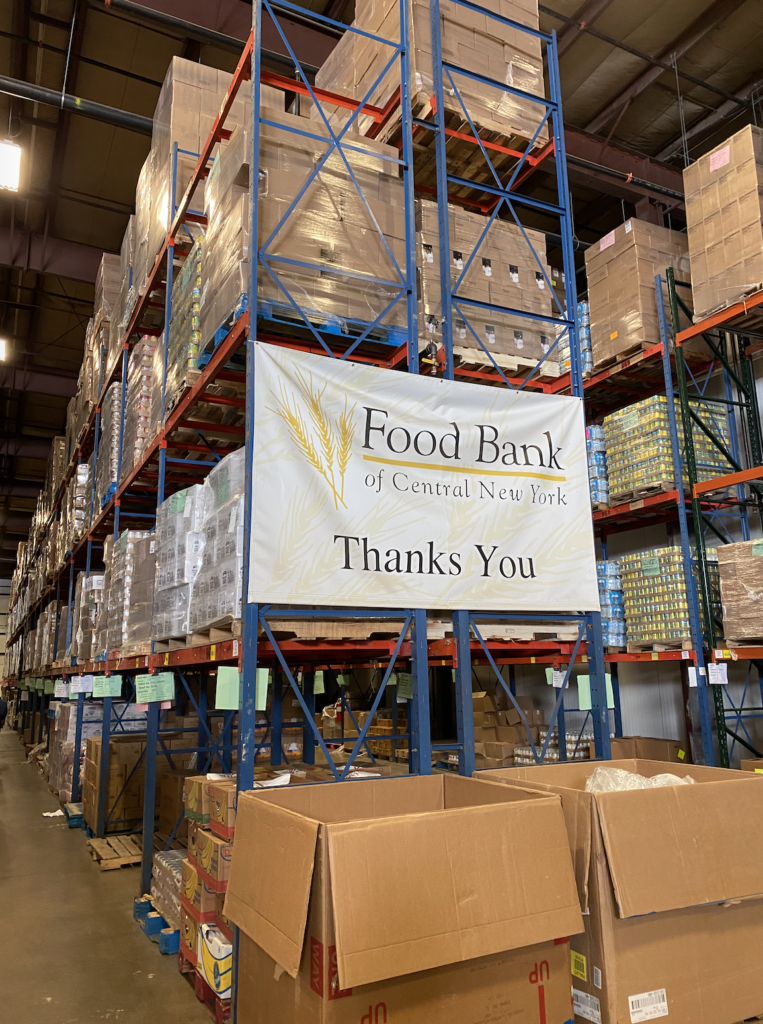On October 8th, 2021 SOFSA staff and board were invited to tour the Food Bank of Central New York (CNY) and get a glimpse into how the food bank receives, organizes, and distributes food to communities in the CNY region. The tour was hosted by Jesse Evin Kerns, program coordinator at Syracuse University’s Center for Sustainable Community Solutions (SU-CSCS), and the food bank’s product donations manager Peter Ricardo. Among those in attendance were Seven Valleys Health Coalition, Hudson Egg farm, SU food studies students, and other local food system leaders. Established in 1985, the Food Bank of CNY is one of the largest food banks operating in the area and serving households in 11 counties (Cayuga, Chenango, Cortland, Herkimer, Jefferson, Lewis, Madison, Oneida, Onondaga, Oswego, and St. Lawrence). In terms of funding, they primarily receive federal funds and funds from the New York State health department and some smaller donations. Before giving the tour, Peter gave a brief overview of the food bank’s history, food programs, stock, and the demographics of those served. He went on to speak about the food bank’s core mission of 20-22 million pounds of food distribution a year. While this is a priority they also do SNAP outreach, education, and sign-up assistance along with providing diet and nutrition help through dieticians. Walking through the 61,000 square foot warehouse we got a behind-the-scenes peek into the facilities distribution area where food is brought in, sorted, and stored or boxed. Peter spoke about how the food is obtained through a donation stream composed of grocers, food manufacturers, local farmers, and businesses. Intake is where the food is sorted and either approved or not based upon certain food and nutrition standards that the food bank follows.
Post-tour, Jesse, and Peter co-led a discussion where we learned more about the successes and challenges the food bank faces. During the pandemic, the food bank struggled to quickly provide shelf-stable food for vulnerable populations and also faced a greater need from families whose children no longer receive school meals. Luckily, they received generous donations and funds from Nourish New York, which provides funding to purchase dairy and produce from 38 local growers and producers who had been impacted by COVID-19. We also discussed various food waste disposal methods (use of animal feeders for waste or energy production and use of anaerobic digestion centers), the new New York state food donation and food scraps recycling law, and food rescue opportunities in the region.
After attending the tour, Paige Clay, SOFSA’s Emerson fellow, was able to interview both Peter and Jesse about their respective work and connections to the food bank. Before working at the food bank, Peter taught at SU and was also involved in food service as a chef. In addition to being production donations manager, Peter is also on the SOFSA board and considers himself a collaborator when it comes to creating partnerships in his work.
Peter: “The nature of the donations involves a lot of partnerships and collaborations in order to make those donations connectable. If you really want to connect surplus food, you have to know all these partners that may be necessary in order to make it viable”.
I also spoke with Jesse who was introduced to the food bank after meeting Peter! Since starting at SU-CSCS in 2015, Jesse has worked on the sustainable systems management team which focuses on promoting waste prevention and reduction-particularly packaging reduction and product stewardship. As he got deeper into waste management work and conducted research on waste combustion facilities and landfills, Jesse quickly realized that the biggest category of waste being sent to these facilities is food. He was later introduced to the food bank of CNY and met Peter.
Jesse: “Most of my work is focused on trying to create a paradigm shift [where] we consider waste as resources that we spent a lot of time getting somehow, you know, through, through, through mining or through timber harvesting or whatever it might be”.
The tour was very educational and gave local leaders a clearer vision of just how impactful the food bank’s work has been and continues to be. It was great getting to know those from different parts of the food system from all over CNY! We’d like to thank both Jesse Kerns and Peter Ricardo for conducting the tour and hosting such an engaging discussion! Jesse is planning another event for the beginning of December to discuss opportunities and barriers to establishing a CNY Food Recovery Network modeled after FeedHV and other local initiatives like Seven Valleys Food Rescue!




